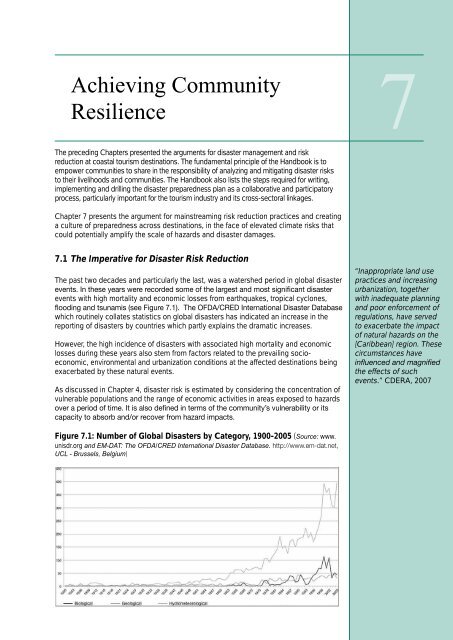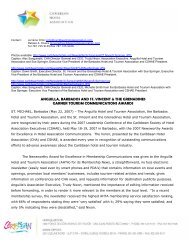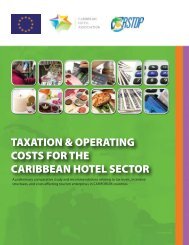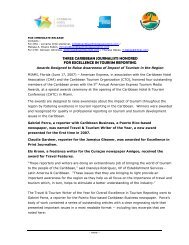Disaster Risk Management for Coastal Tourism - Caribbean Hotel ...
Disaster Risk Management for Coastal Tourism - Caribbean Hotel ...
Disaster Risk Management for Coastal Tourism - Caribbean Hotel ...
Create successful ePaper yourself
Turn your PDF publications into a flip-book with our unique Google optimized e-Paper software.
7<br />
Achieving Community<br />
Resilience<br />
7<br />
The preceding Chapters presented the arguments <strong>for</strong> disaster management and risk<br />
reduction at coastal tourism destinations. The fundamental principle of the Handbook is to<br />
empower communities to share in the responsibility of analyzing and mitigating disaster risks<br />
to their livelihoods and communities. The Handbook also lists the steps required <strong>for</strong> writing,<br />
implementing and drilling the disaster preparedness plan as a collaborative and participatory<br />
process, particularly important <strong>for</strong> the tourism industry and its cross-sectoral linkages.<br />
Chapter 7 presents the argument <strong>for</strong> mainstreaming risk reduction practices and creating<br />
a culture of preparedness across destinations, in the face of elevated climate risks that<br />
could potentially amplify the scale of hazards and disaster damages.<br />
7.1 The Imperative <strong>for</strong> <strong>Disaster</strong> <strong>Risk</strong> Reduction<br />
The past two decades and particularly the last, was a watershed period in global disaster<br />
<br />
events with high mortality and economic losses from earthquakes, tropical cyclones,<br />
<br />
which routinely collates statistics on global disasters has indicated an increase in the<br />
reporting of disasters by countries which partly explains the dramatic increases.<br />
However, the high incidence of disasters with associated high mortality and economic<br />
losses during these years also stem from factors related to the prevailing socioeconomic,<br />
environmental and urbanization conditions at the affected destinations being<br />
exacerbated by these natural events.<br />
As discussed in Chapter 4, disaster risk is estimated by considering the concentration of<br />
vulnerable populations and the range of economic activities in areas exposed to hazards<br />
<br />
<br />
“Inappropriate land use<br />
practices and increasing<br />
urbanization, together<br />
with inadequate planning<br />
and poor en<strong>for</strong>cement of<br />
regulations, have served<br />
to exacerbate the impact<br />
of natural hazards on the<br />
[<strong>Caribbean</strong>] region. These<br />
circumstances have<br />
<br />
the effects of such<br />
events.” CDERA, 2007<br />
Figure 7.1: Number of Global <strong>Disaster</strong>s by Category, 1900-2005 (Source: www.<br />
unisdr.org and EM-DAT: The OFDA/CRED International <strong>Disaster</strong> Database. <br />
UCL - Brussels, Belgium)<br />
85








